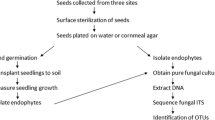Abstract
The parasitic fungus Rhytisma polare is a common parasite on leaves of the polar willow (Salix polaris) in the high-Arctic polar semi-desert of Spitsbergen, Norway. Because Rhytisma spp. generally requires saturation with free water to develop ascospores, it is unclear how R. polare has ecologically adapted to the Arctic desert, where such water is very limited. In this study, the response of R. polare to different water conditions on Spitsbergen was investigated during the summer months of June–August in 2012. Field and laboratory experiments demonstrated that free water availability from rainfall or snowmelt is essential to facilitate ascostromal maturation and ascospore dispersal in R. polare. The field experiments also revealed that the dispersal of ascospores produced on fallen leaves did not extend beyond a few meters. These results suggest that the free water requirement combined with the short spore-dispersal distance constrains the local occurrence of R. polare in the Arctic desert to locations where free water from rainfall and snowmelt is present.





Similar content being viewed by others
References
Bevan RJ, Greenhaigh GN (1976) Rhytisma acerinum as a biological indicator of pollution. Environ Pollut 10:271–285
Bliss LC, Svoboda J (1984) Plant communities and plant production in the western Queen Elizabeth Islands. Holarct Ecol 7:325–344
Brintanja R, Selten FM (2014) Future increases in Arctic precipitation linked to local evaporation and sea ice retreat. Nature 509:479–482
Cannon PF, Minter DW (1986) The Rhytismataceae of the Indian subcontinent. Mycol Pap 155:1–123
Gosling L, Ashmore M, Sparks T, Bell N (2016) Citizen science identifies the effects of nitrogen dioxide and other environmental drivers on tar spot of sycamore. Environ Pollut 214:549–555
IPCC (2013) Stocker TF, Qin D, Plattner GK, Tignor M, Allen SK, Boschung J, Nauels A, Xia Y, Bex V, Midgley PM (eds) In: Climate change 2013: the physical science basis. contribution of working group I to the fifth assessment report of the intergovernmental panel on climate change. Cambridge University Press, Cambridge
Jones SG (1925) Life-history and cytology of Rhytisma acerinum (pers.) Fries. Ann Bot 39:41–75
Jung JY, Lee K, Lim HS, Kim H, Lee EJ, Lee YK (2014) Soil organic carbon characteristics relating to geomorphology near Vestre Lovénbreen moraine in Svalard. J Ecol Environ 37:69–79
Leith ID, Fowler D (1988) Urban distribution of Rhytisma acerinum (Pers.) Fries (tar spot) on sycamore. New Phytol 108:175–181
López-Moreno JI, Boike J, Sanchez-Lorenzo A, Pomeroy JW (2016) Impact of climate warming on snow processes in Ny-Ålesund, a polar maritime site at Svalbard. Glob Planet Chang 146:10–21
Masumoto S, Tojo M, Uchida M, Imura S (2014) Rhytisma polaris: morphological and molecular characterization of a new species from Spitsbergen Island, Norway. Mycol Prog 13:181–188
Muller K (1912a) Zur Biologie der Schwarzlleckcnkrankheit der Ahornbiiume, hervorgerufen durch den Pilz Rhytisma acerinum. Zentralbtatt fiir Bakteriologie Parasitenkunde Infektionskrankheiten und Hygiene. Abt ii Bd 36:67–98
Muller K (1912b) Uber das biologische Verhalten von Rhytisma acerinum auf verschiedenen. Ahornarten Bericht der Deutschen botanischen Gesellschaft (Berlin) 30:385–391
Muraoka H, Uchida M, Mishio M, Nakatsubo T, Kanda H, Koizumi H (2002) Leaf photosynthetic characteristics and net primary production of the polar willow (Salix polaris) in a high arctic polar semi-desert, Ny-Ålesund, Svalbard. Can J Bot 80:1193–1202
Skarpe C, van der Wal R (2002) Effects of simulated browsing and length of growing season on leaf characteristics and flowering in a deciduous Arctic shrub, Salix polaris. Arct Antarct Alp Res 34:282–286
Uchida M, Muraoka H, Nakatsubo T (2016) Sensitivity analysis of ecosystem CO2 exchange to climate change in high Arctic tundra using an ecological process-based model. Polar Biol 39:251–265
Acknowledgements
We are grateful to Dr. Naoyuki Matsumoto for critical reviewing the manuscript. This work was supported by a Grant from SOKENDAI (The Graduate University for Advanced Studies), the National Institute of Polar Research (Research Project KP‒11), and the Green Network of Excellence (GRENE) Program to SM, SI, and MU and by a JSPS Grant-in-aid for scientific research (no. 15K00626) to MT. This work was also supported by the Arctic Challenge for Sustainability Project (ArCS) Grant provided by the Ministry of Education, Culture, Sports, Science, and Technology, Japan. We thank Barbara Goodson, PhD, from Edanz Group (www.edanzediting.com/ac) for editing an earlier version of this manuscript.
Author information
Authors and Affiliations
Corresponding author
Ethics declarations
Conflict of interest
The authors declare that they have no conflict of interest.
Rights and permissions
About this article
Cite this article
Masumoto, S., Tojo, M., Imura, S. et al. Occurrence pattern of the parasitic fungus Rhytisma polare (Ascomycota) on the polar willow (Salix polaris) under limited water conditions in a high-Arctic semi-desert. Polar Biol 41, 1105–1110 (2018). https://doi.org/10.1007/s00300-018-2269-6
Received:
Revised:
Accepted:
Published:
Issue Date:
DOI: https://doi.org/10.1007/s00300-018-2269-6




